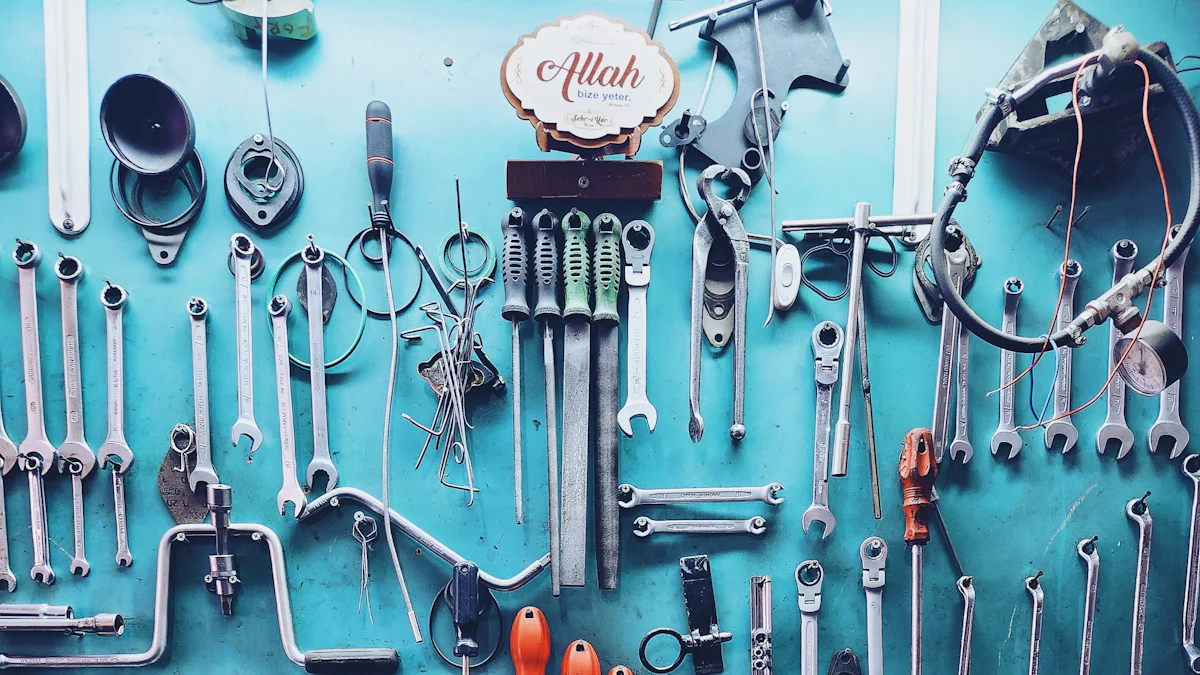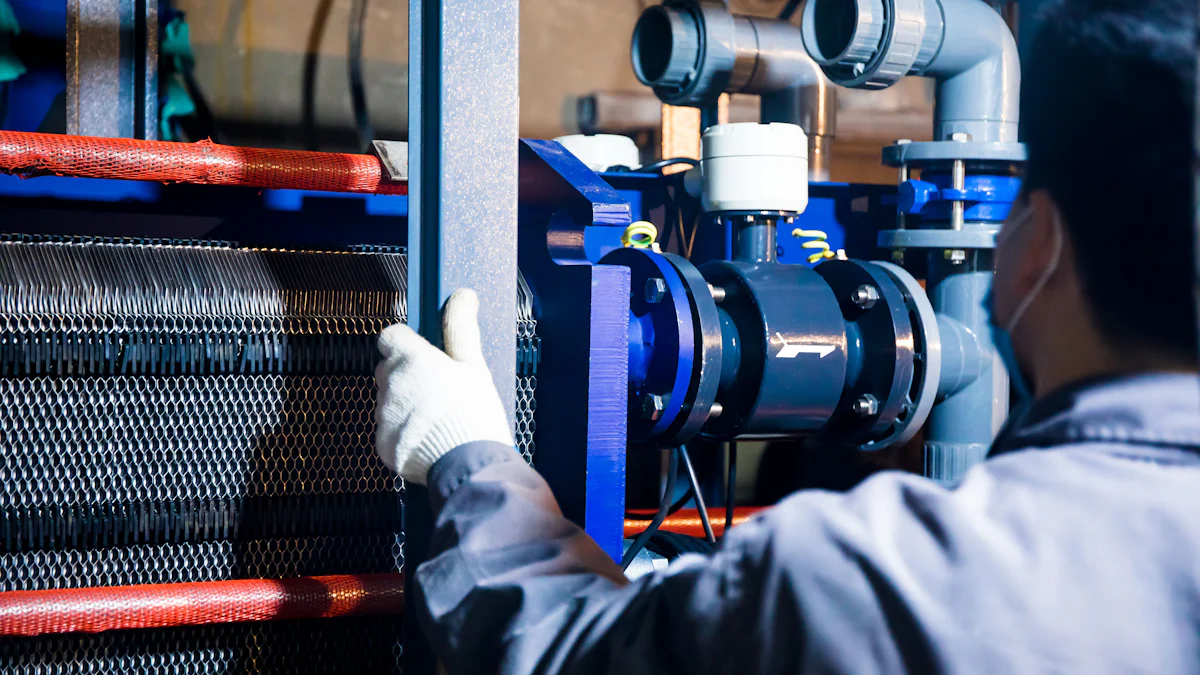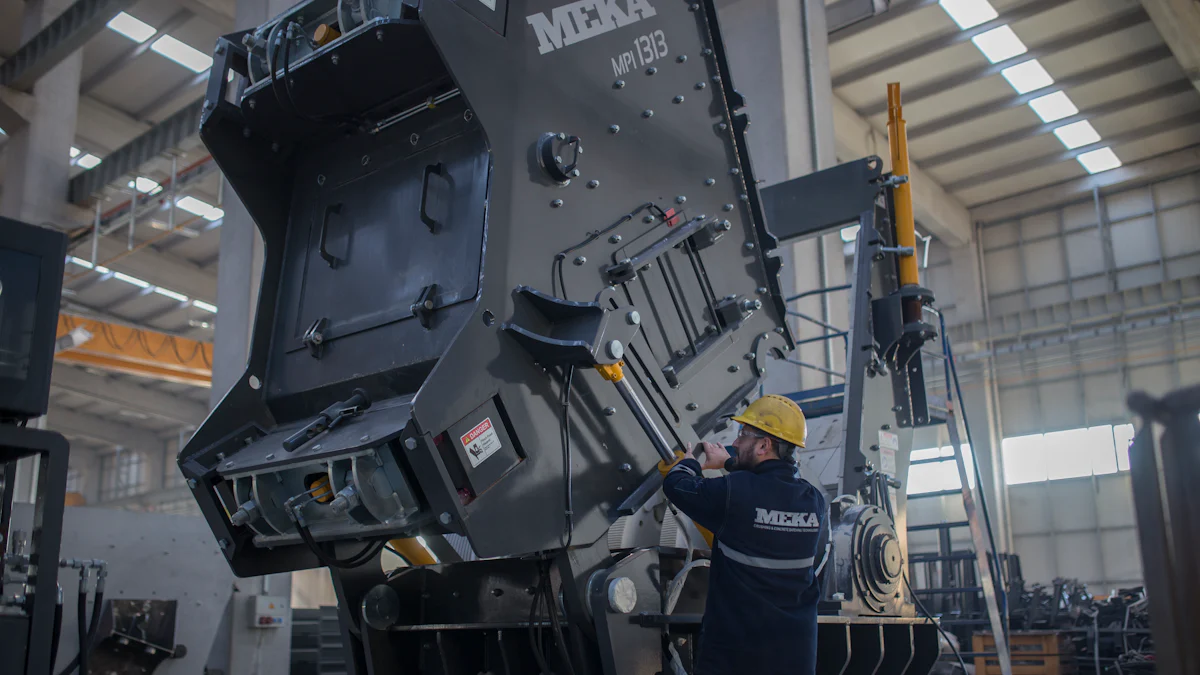
Taking care of your lighter making machine is essential. It keeps your operations smooth, safe, and cost-efficient. Regular maintenance prevents breakdowns and extends the machine’s life. Whether you’re using a standard model or a High Quality Lighter Assembly Press Automatic Cigarette Lighter Making machine, proper upkeep ensures better performance and fewer interruptions in your production process.
Key Takeaways
- Check your lighter machine often to find small problems early. Look for damage, check moving parts, and see if belts are tight.
- Take care of your machine to stop big problems later. Oil it well and replace old parts on time to keep it working.
- Cleaning your machine is very important. Remove dust and dirt often, use safe cleaners, and blow air into tight spots to keep it working well.
Regular Inspections
Keeping your lighter making machine in top shape starts with regular inspections. These checks help you catch small issues before they turn into costly repairs. Let’s break it down into three key areas you should focus on.
Checking for Wear and Tear
Every machine experiences wear and tear over time. Look closely at components like gears, screws, and joints. Are there any cracks, rust, or signs of damage? If you notice anything unusual, don’t ignore it. Replacing worn-out parts early can save you from bigger headaches later. Think of it as giving your machine a health check-up—it’s better to be safe than sorry.
Inspecting Moving Parts
Moving parts are the heart of your machine. They keep everything running smoothly. Take time to inspect these parts for proper alignment and smooth operation. If something feels off, it could mean trouble down the line. Pay attention to noises too. A squeak or grind might seem minor, but it’s often a sign that something needs attention. Regularly inspecting these parts ensures your machine stays efficient and reliable.
Monitoring Belts and Tension
Belts play a crucial role in your machine’s performance. Over time, they can loosen or wear out. Check the tension regularly to make sure it’s just right—not too tight, not too loose. A poorly adjusted belt can lead to inefficiency or even damage other parts. If you spot fraying or cracks, replace the belt immediately. Keeping an eye on this detail helps your machine run like a well-oiled engine.
Pro Tip: Set a schedule for these inspections. Consistency is key to catching problems early and keeping your lighter making machine in peak condition.
Preventive Maintenance
Preventive maintenance is like giving your lighter making machine a little TLC. It’s all about keeping things running smoothly and avoiding unexpected breakdowns. Let’s dive into three key areas you should focus on.
Importance of Lubrication
Think of lubrication as the lifeblood of your machine. Without it, moving parts grind against each other, causing wear and tear. Regularly applying the right lubricant reduces friction and keeps everything running like clockwork. Check the manufacturer’s guidelines to know which lubricant works best for your machine. Don’t skip this step—it’s quick, easy, and saves you from costly repairs later.
Tip: Keep a small checklist handy to track which parts need lubrication and when. This simple habit can make a big difference.
Timely Replacement of Worn Parts
Worn-out parts are like ticking time bombs. They might seem harmless at first, but they can lead to bigger problems if ignored. Inspect components like gears, belts, and seals regularly. If you notice cracks, rust, or excessive wear, replace them immediately. Staying proactive ensures your lighter making machine stays reliable and efficient.
Calibrating the Machine for Consistency
Calibration is key to maintaining precision. Over time, your machine might lose its alignment, affecting the quality of the lighters it produces. Regularly calibrate it to ensure consistent performance. Follow the manufacturer’s instructions or consult a professional if needed. A well-calibrated machine not only improves output but also reduces waste.
Pro Tip: Schedule calibration checks every few months to keep your machine in top shape.
Cleaning Practices

Keeping your lighter making machine clean is essential for its performance and longevity. Dust, debris, and residue can build up over time, causing inefficiency or even damage. Let’s explore how you can maintain a spotless machine.
Removing Dust and Debris
Dust and debris are your machine’s silent enemies. They sneak into crevices and moving parts, slowing things down. Use a soft brush or a lint-free cloth to wipe surfaces regularly. Pay extra attention to areas around gears and belts. If you let debris pile up, it can clog the system and lead to costly repairs. A quick daily clean can save you a lot of trouble.
Using Safe Cleaning Agents
Not all cleaning agents are created equal. Some can harm your machine’s components. Always choose cleaners recommended by the manufacturer. Avoid harsh chemicals that might corrode metal parts or damage seals. A mild, non-abrasive cleaner works best. Test it on a small area first to ensure it’s safe. Using the right cleaning agent keeps your machine in top condition without risking damage.
Tip: Store cleaning supplies nearby so you can clean up spills or residue immediately. Quick action prevents buildup.
Cleaning Hard-to-Reach Areas with Compressed Air
Some parts of your machine are hard to reach with a cloth or brush. That’s where compressed air comes in handy. Use it to blow out dust and debris from tight spaces. Focus on areas like vents, joints, and small openings. Be gentle, though—too much pressure can dislodge delicate parts. Regular use of compressed air keeps your machine running smoothly.
Pro Tip: Wear safety goggles when using compressed air. It protects your eyes from flying particles.
Quality Spare Parts
When it comes to maintaining your lighter making machine, the quality of spare parts matters more than you might think. Using the right components ensures smooth operation and prevents unnecessary breakdowns. Let’s explore how you can make smart choices when sourcing spare parts.
Avoiding Counterfeit Components
Counterfeit parts might seem like a bargain, but they can cost you more in the long run. These low-quality components often wear out quickly or fail to meet the required standards. They can damage your machine or even compromise safety. Always double-check the authenticity of the parts you’re buying. Look for proper branding, serial numbers, or certifications. If something feels off, trust your instincts and avoid it. Sticking to genuine parts keeps your machine running efficiently and saves you from unexpected repairs.
Tip: If a deal seems too good to be true, it probably is. Don’t risk your machine’s performance for short-term savings.
Sourcing from Trusted Suppliers
Finding a reliable supplier is key to getting high-quality spare parts. Work with suppliers who have a good reputation and experience in the industry. Ask for recommendations or read reviews to ensure you’re dealing with a trustworthy source. A good supplier will provide detailed product information and offer warranties. They’ll also guide you in choosing the right parts for your machine. Building a relationship with a trusted supplier gives you peace of mind and ensures you always have access to quality components.
Pro Tip: Keep a list of verified suppliers handy. It’ll save you time and effort when you need parts urgently.
Operator Training

Hands-On Training for Operators
Your operators are the backbone of your production process. Giving them hands-on training ensures they know how to handle the lighter making machine effectively. Start by walking them through the basic functions of the machine. Let them operate it under supervision to build confidence. Real-world practice helps them understand how the machine behaves during production.
Encourage them to ask questions and experiment with different settings. This approach not only improves their skills but also boosts their problem-solving abilities. A well-trained operator can spot issues early and keep the machine running smoothly.
Tip: Create a checklist of essential tasks for operators to follow during training sessions. It keeps the learning process organized and thorough.
Basics of Troubleshooting
No machine runs perfectly all the time. Teaching your operators basic troubleshooting skills can save you time and money. Show them how to identify common problems like misaligned parts or unusual noises. Explain what steps to take when these issues arise.
For example, if the machine stops unexpectedly, they should know how to check for blockages or loose connections. Simple fixes like these can prevent bigger problems. Troubleshooting skills empower your team to act quickly and minimize downtime.
Pro Tip: Keep a troubleshooting guide near the machine. It’s a handy reference for operators when they face unexpected issues.
Understanding Electrical and Pneumatic Systems
Modern lighter making machines often rely on electrical and pneumatic systems. Operators should understand how these systems work. Teach them the basics, like how to check for electrical faults or inspect air pressure levels.
Explain the importance of safety when dealing with these systems. For instance, they should always turn off the power before inspecting electrical components. Similarly, they must release air pressure before working on pneumatic parts. A solid understanding of these systems ensures safer and more efficient operations.
Note: Consider scheduling periodic refresher courses to keep operators updated on new techniques and safety protocols.
Performance Monitoring
Keeping track of your lighter making machine’s performance is crucial. It helps you spot inefficiencies and maintain consistent output. With the right tools and techniques, you can ensure your machine operates at its best.
Using Sensors to Track Metrics
Sensors are your best friends when it comes to monitoring performance. They provide real-time data on key metrics like temperature, pressure, and speed. This information helps you identify potential issues before they escalate. For example, if a sensor detects overheating, you can address it immediately instead of waiting for a breakdown. Install sensors in critical areas of your machine and check the readings regularly. It’s a simple way to stay ahead of problems.
Tip: Use a centralized system to collect and analyze sensor data. It saves time and gives you a clear picture of your machine’s health.
Identifying Performance Trends
Tracking performance over time reveals valuable trends. Are there specific times when your machine slows down? Do certain parts wear out faster than others? By analyzing these patterns, you can make informed decisions about maintenance and upgrades. Keep a log of performance data and review it monthly. This habit helps you spot inefficiencies and improve productivity.
Pro Tip: Use graphs or charts to visualize trends. It makes the data easier to understand and act on.
Monitoring Nozzle, Valve, and Ignition Needle
The nozzle, valve, and ignition needle are critical components of your lighter making machine. If any of these parts fail, production can grind to a halt. Inspect them regularly for signs of wear or misalignment. Clean the nozzle to prevent clogs, check the valve for proper sealing, and ensure the ignition needle sparks consistently. A little attention to these parts goes a long way in maintaining smooth operations.
Note: Replace these components immediately if you notice any damage. Delaying repairs can lead to bigger problems.
Proper Tooling
The tools you use for maintaining your lighter making machine can make or break your efforts. Having the right tools and storing them properly ensures smooth maintenance and avoids unnecessary delays.
Choosing the Right Tools
Using the correct tools is essential for effective maintenance. A mismatched tool can damage your machine or make repairs harder than they need to be. Always refer to your machine’s manual to identify the recommended tools for specific tasks. For example, if you’re tightening bolts, use a torque wrench instead of a regular one. It ensures precision and prevents over-tightening.
Keep a basic toolkit handy with essentials like screwdrivers, pliers, and hex keys. If your machine has specialized components, invest in tools designed for those parts. High-quality tools may cost more upfront, but they last longer and perform better. Think of them as an investment in your machine’s health.
Tip: Label your tools for easy identification. It saves time when you’re in the middle of a repair.
Storing Tools Safely
Proper storage keeps your tools in good condition and prevents accidents. Use a toolbox or a pegboard to organize them neatly. Avoid leaving tools scattered around, as this can lead to damage or injuries. If your tools are prone to rust, store them in a dry place and consider using anti-rust sprays.
Create a habit of cleaning your tools after every use. Wipe off grease or debris to keep them functional. Also, inspect them regularly for wear and tear. A well-maintained tool is always ready when you need it.
Pro Tip: Use foam inserts in your toolbox to keep tools secure and prevent them from shifting during transport. It’s a small step that makes a big difference.
Maintenance Logs
Keeping detailed maintenance logs is one of the smartest things you can do for your lighter making machine. It helps you stay organized and ensures nothing slips through the cracks. Let’s break it down into three key steps.
Recording Maintenance Activities
Start by writing down every maintenance task you perform. Whether it’s a quick belt adjustment or a full calibration, document it. Use a notebook, spreadsheet, or even a maintenance app—whatever works best for you. Include details like the date, the task performed, and any parts replaced. This record acts as a history book for your machine. It helps you track what’s been done and when.
Tip: Add a “notes” section to your log. It’s a great place to jot down observations or issues you notice during maintenance.
Identifying Patterns and Trends
Your maintenance log isn’t just a record—it’s a goldmine of information. Review it regularly to spot patterns. Are certain parts wearing out faster than expected? Does the machine need lubrication more often during peak production? These trends can reveal underlying issues or areas for improvement. Use this insight to tweak your maintenance routine and keep your machine running smoothly.
Pro Tip: Highlight recurring issues in your log. It makes them easier to spot and address.
Establishing a Regular Maintenance Schedule
Consistency is key to effective maintenance. Use your log to create a schedule that works for your machine. Plan tasks like inspections, lubrication, and part replacements at regular intervals. Stick to this schedule to prevent problems before they start. A well-maintained machine is a reliable machine.
Note: Set reminders for scheduled tasks. It’s an easy way to stay on top of your maintenance game.
Maintaining your lighter making machine doesn’t have to be complicated. Regular inspections, cleaning, and proper training keep it running smoothly. These efforts reduce downtime, improve efficiency, and extend its lifespan. Start applying these tips today. You’ll see the difference in performance and reliability. A little care goes a long way!
FAQ
What’s the best way to schedule maintenance for my machine?
Use a calendar or maintenance app to set reminders. Stick to a routine for inspections, lubrication, and part replacements. Consistency keeps your machine running smoothly. 🛠️
How often should I clean my lighter making machine?
Clean it daily to remove dust and debris. Use compressed air weekly for hard-to-reach areas. Regular cleaning prevents buildup and extends the machine’s lifespan. ✨
Can I use generic spare parts for my machine?
Avoid generic parts. They may not meet quality standards and could damage your machine. Always source components from trusted suppliers for reliability and safety. ✅

